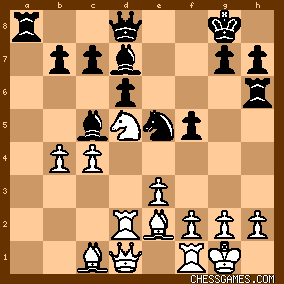Apr-01-20
 | | Phony Benoni: This is why correspondence chess was invented. I cannot imagine walking into this mess with White over-the-board. |
|
| Apr-14-20 | | dumbgai: Antonie K. defeated Antonie K. |
|
Apr-14-20
 | | An Englishman: Good Evening: Curious aspect about this game--White put so much emphasis upon control the d5 square. 13.Ra2 proved far-sighted; after the redeployment to d2, the Bishop had a convenient post at b2. The Rook would later prevent mate at g2. |
|
Apr-14-20
 | | scormus: hot mail, cool play |
|
| Apr-14-20 | | goodevans: Exciting stuff. Two all-out attacks. I wouldn't have been able to predict which would succeed even under correspondence conditions. Black missed a puzzle-like continuation after 17.axb4 that would have yielded a small but lasting advantage. 
click for larger viewTo be fair though, he would have needed to have realised that 'a small but lasting advantage' would have been preferable to the attack that he pursued. |
|
Apr-14-20
 | | scormus: A remarkable game, for many reasons. Playing through it I had the feeling that B was sometimes on the point of gaining a clear advantaage, but amazingly wasn't able to grasp the nettle. The position after 23 Rxc7? was most glaring. The Ra8 was poison but B played the nothing defensive move 23 ... Rc8? and W was able to continue 24 f5+ Kh8 25 Qf7. If instead 23 .... Rg6! then 24 c5+ Kh8 and W seems to have no adequate defense to the threat of 25 ... hxg2 26 Rxg2 Rxg2+ 27 Bh3+. |
|
| Apr-14-20 | | mrknightly: AK AK attacks. |
|
| Apr-14-20 | | Brenin: <goodevans> Yes, 17 ... f4 would have been interesting, e.g. 18 bxc5 Qh4 with a winning attack, or 18 Nxf4 Ba4 winning the exchange. |
|
| Apr-14-20 | | goodevans: <scormus: [...] I had the feeling that B was sometimes on the point of gaining a clear advantaage...> Until I read your post I thought almost the exact opposite. I was under the mistaken impression that white had held a steadily increasing advantage from move 18. Now I realise he had let it slip. I started to look for where he went wrong and with hindsight <20.f4> seems to be where that started. I really don't like that move which weakened e3 and g3. There seem to be a handful of preferable moves, including <20.Qb3>. Even after 20.f4 white would probably still have been OK with very accurate play but now <22.Qb3> is too late. <22.c5> and <22.f5> both seem to be better tries. Tartakower said "Victory goes to the player who makes the next-to-last mistake" and this time white got lucky. |
|
Apr-14-20
 | | AylerKupp: What can I say? The players' parents thought that AK was a good acronym for their sons' names. So did Karpov's parents. |
|
Apr-14-20
 | | scormus: <goodevans> Thanks, I agree with you about 20 f4. Even without any analysis it simply looked wrong. W seemingly lost his way here and was lucky to find it again. 22 ... c6 might have put W in trouble with e3 so weak - B could easily afford Nc7/Nxa8. However, the text move 22 ... gxh3 looked appealing as well. When I played it through first time I was expecting at some point the natural follow up, .... hxg2, or possibly ... h2+, but it never came. |
|
Apr-14-20
 | | Phony Benoni: It's possible the last mistake came after <24.c5+>:
click for larger viewNow <24...Kh8> is instinctual, especially since <25.Qf7> does not look devastating at first glance. But if Black stops that move with 25...Kf8, can White blast through first? |
|
| Apr-14-20 | | ajile: <AylerKupp: What can I say? The players' parents thought that AK was a good acronym for their sons' names. So did Karpov's parents.> I spent about 5 hours doing exhaustive research and can say with confidence that this is your shortest post ever. :o) |
|
| Apr-15-20 | | Morten: Nice finish after black tries 27.-Rg6: 28.Qf8+, Rxf8 29.fxg7+ and mate by Rxf8 next. White's moves can be reversed for a less flashy effect. |
|
| Apr-20-20 | | Ironmanth: And THIS is why I have ever treasured the older correspondence games - inevitably very rich, complex, and wonderful. Thanks, chessgames. Everyone please stay safe. |
|





